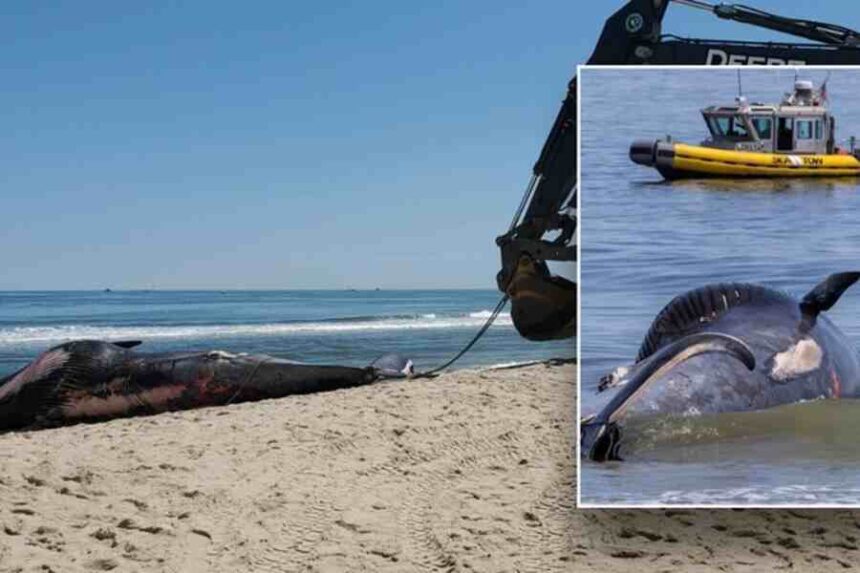In a shocking incident that has raised concerns among marine conservationists, an MSC Cruises ship docked at a New York City port with a 44-foot (13-meter) endangered sei whale lifeless across its bow. This tragic discovery has underscored the devastating effects that human activity can have on marine life. Sei whales, which are typically found in deeper waters and are rarely seen near shorelines, have been classified as endangered due to a long history of commercial whaling and ongoing human impact.
The incident occurred as the MSC Meraviglia, one of MSC Cruises’ fleet, sailed into the Port of Brooklyn. Marine authorities alerted to the distressing sight, launched an immediate investigation into how the whale came to be struck by the vessel. The sei whale’s death has prompted a renewed call from conservationists for stricter regulations on commercial fishing and shipping, particularly in regions known to harbor vulnerable marine species.
Environmental organizations advocate for enhanced protective measures, including altering shipping lanes and reducing ship speeds near known whale habitats, to mitigate the risk of vessel strikes. This incident serves as a grim reminder of the urgency required in implementing and enforcing such measures to protect these majestic creatures from further harm.
The MSC Meraviglia, one of MSC Cruises’ prominent vessels, docked at the Port of Brooklyn on Saturday, tragically bearing a lifeless 44-foot sei whale across its bow. The whale’s unfortunate discovery sent shockwaves through the marine biology community. Andrea Gomez, a spokesperson for the National Oceanic and Atmospheric Administration (NOAA) fisheries department, confirmed that the whale was a sei whale—a species listed as endangered and typically seen far from coastal waters in deeper ocean habitats.
Once officials realized the grim reality of the situation, immediate steps were taken to notify the relevant authorities. To enable a detailed examination, the whale was carefully relocated and towed to Sandy Hook, New Jersey, where marine biologists and veterinarians could conduct a necropsy (an autopsy for animals) with the necessary equipment and resources. The necropsy aims to clarify the circumstances of the whale’s death, including whether it was already deceased when it collided with the ship or whether the vessel was directly responsible.
Initial observations noted signs of significant trauma, including broken bones in the right flipper and extensive injuries along the shoulder region, raising pressing questions about how the collision occurred. This discovery has sparked calls for further measures to safeguard marine wildlife and prevent future incidents involving endangered species.
On Tuesday, marine biologists conducted a necropsy on the 44-foot sei whale to ascertain the circumstances surrounding its death. Samples collected from the whale’s tissue and bone structures were essential to understanding the timing and cause of the fatal injuries. Preliminary findings revealed signs of significant trauma, including fractures in the right flipper and severe damage to the shoulder region. This evidence suggested that the whale might have collided with the MSC Meraviglia while still alive.
Andrea Gomez, the spokesperson for NOAA’s fisheries department, emphasized that NOAA’s Office of Law Enforcement was actively investigating the incident to determine the precise timeline and assess the role of the cruise ship in the whale’s death. By analyzing tissue and bone samples, scientists hope to clarify whether the whale had already succumbed to other factors before encountering the ship or whether the injuries resulted directly from the vessel strike.
The investigative findings will inform potential regulatory actions and future conservation strategies. Collisions between ships and marine mammals remain a critical concern for environmental groups, particularly when endangered species like sei whales are affected. The results of this investigation could lead to updated safety measures and policies designed to minimize the risk of similar incidents occurring in the future.
In response to the tragic death of the sei whale, MSC Cruises expressed deep regret and reiterated its commitment to adhering to international regulations aimed at safeguarding marine life. Sidney Sterling, Director of Media Relations for MSC Cruises, emphasized that the cruise line has comprehensive measures in place to prevent such incidents.
MSC collaborates with the Ocean Research & Conservation Association (ORCA) to provide specialized training for its deck officers, helping them identify and steer clear of whale habitats.
Sterling highlighted that MSC Cruises routinely adjusts its itineraries to avoid areas known to harbor whales and other sensitive marine species. The company has established protocols for altering course and reducing speed in certain regions, minimizing the risk of collisions.
Furthermore, Sterling explained that MSC Cruises actively works with environmental partners and relevant authorities to continuously refine and improve its safety procedures.
While acknowledging the incident’s unfortunate outcome, Sterling reaffirmed the cruise line’s dedication to protecting marine life. He noted that MSC would continue to review and enhance its protocols, aiming to mitigate similar risks in the future. The company is fully cooperating with NOAA’s ongoing investigation and is committed to implementing any recommendations that emerge from the inquiry to prevent future accidents.The incident involving the endangered sei whale is part of a broader pattern of marine life fatalities along the East Coast. Last month, a North Atlantic right whale—a critically endangered species—was found dead off Virginia Beach after a collision with a ship. Environmental organizations are urging stricter regulations to prevent such tragedies, including limiting ferry speeds near whale habitats. However, ferry companies counter that such measures would severely impact service and argue their captains rarely spot right whales.
As the necropsy results are pending, the marine biology community and environmental groups are watching closely to see what this incident reveals about human activity’s effects on marine ecosystems.
With sei whales consuming up to 2,000 pounds of fish and plankton daily, reaching lengths of 60 feet, and living between 50 to 70 years, the death of such a magnificent creature is a significant loss that underscores the urgency of preventing similar incidents.




